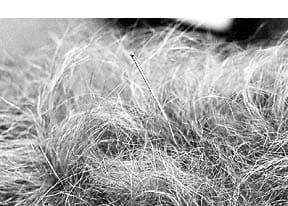It is generally accepted that the practice of human and veterinary acupuncture had their beginnings in ancient China. According to legend, veterinary acupuncture was discovered when lame horses were used for battle and became sound after being pierced by arrows at distinct points.
Regardless of the accuracy of the folklore, there is evidence that veterinarians practiced acupuncture around 2000-3000 BC. The early use of the technique on animals was probably prompted by the economic importance of horses, camels, elephants, cows, pigs, and chickens as sources of transportation and food. Now, veterinary acupuncture is used worldwide to treat all types of animals including many exotics.
Acupuncture gets its name form the Latin words acus, which means needle, and pungare which means to pierce. Most of us can conjure up images of an acupuncture session, but few understand the reasoning behind needling – perhaps because there are several schools of thought that purport to explain the effectiveness of the practice.

According to practitioners of Traditional Chinese Medicine, there are channels of energy, called meridians, that run in regular patterns through the body and over its surface. The energy, called Qi or Chi, flows in these meridians just like water flows in a stream. If something blocks the flow of energy, it backs up, much as water would back up if a dam were placed across a stream. Disease results from disturbances or imbalances in the energy. Placing needles at specific points, called acupuncture points or acupoints, unblocks the obstructions in the meridians and reestablishes the free flow of energy.
The theory is that by restoring energy circulation through the meridians, acupuncture treatments allow the body’s internal organs to correct imbalances in digestion, absorption, and energy production. This is thought to encourage the body to use its own healing powers to correct imbalances and disharmony that manifest as disease or lameness. Acupuncture, therefore, is a means of balancing the energy in the body and allowing the body to heal. Because acupuncture helps maintain the body’s balance, it is also a powerful tool for preventing disease.
The Western perspective
While it was clear that acupuncture has a long history of effective treatment of many injuries and diseases, scientists using traditional diagnostic tools have been unable, until recently, to explain how therapy works. In the last 25 years, however, Western scientists have made enormous strides toward understanding the curative mechanisms and the physiological basis of acupuncture.
For example, scientists have learned that the epidermis at acupuncture points is usually thinner than that of surrounding areas. Below the surface of the skin, each acupuncture point has a unique structure composed of a thin connective tissue column surrounded by thicker connective tissue. The column or acupuncture point contains a lymph vessel, arteriole, and vein that are surrounded by a network of nerve fibers.

Bruce Pomerantz, Ph.D., a neuroscientist at the University of Toronto, has done extensive research on the nerve pathways that are affected during acupuncture therapy. Dr. Pomerantz has published his research in numerous scientific articles and eight textbooks on acupuncture.
Dr. Pomerantz’s research has shown that when an acupuncture needle pierces the skin and underlying muscle, it stimulates some of the nerve fibers which carry messages to brain to release endorphins, morphine-like compounds that block pain pathways in the brain.
Endorphins are often referred to as “the feel-good” substances that are released naturally and account for feelings of euphoria such as the “runner’s high.” Only those acupoints associated with treating pain are involved with the release of endorphins.
Other acupoints provide effects such as the release of cortisol, a natural steroid. Research is ongoing to determine how stimulation of these acupoints affect the body.
Acupuncture and moxibustion
Acupuncture therapy involves the insertion of very thin needles into precise anatomical locations or acupuncture points on the body to balance the body’s energy and produce a healing effect.

Acupuncture needles are solid, flexible, stainless steel needles with a smooth shaft that is rounded at the tip. At most, there may be a momentary sensation of pain as the needle is inserted. No pain should occur after the needle is in place. This is unlike hypodermic needles that are pointed and have sharp cutting edges surrounding the hollow barrel and may be painful when inserted. Both reusable needles that must be sterilized after each use and disposable needles are available. Both types are designed to stimulate the acupoints and produce a result such as the release of endorphins from the brain.
As noted above, other types of acupoints produce other types of physiological changes within the body. The goal of acupuncture therapy is to encourage the body to promote natural healing and to improve function.
Needling isn’t the only way to stimulate acupoints. As a matter of fact, the Chinese word for acupuncture is zhenjiu. It comes from zhen, which means needle, and jiu, which means moxibustion. In Chinese medicine, acupuncture and moxibustion are considered part of one therapy. Moxibustion is a method of heating or stimulating acupuncture points by burning an herb over them. Moxa, from the Japanese moe kusa or burning herb, refers to the herb mugwort (Artemisia vulgaris) which is related to the chrysanthemum family. The mature leaves of the plant, which have a wooly underside, are harvested, cured by drying in the sun, and ground into a fine powder or “wool” that is shaped into cones.
Commercially available moxa sticks are 6-12 inches long and about a half-inch in diameter. The end is ignited and then blown out so that it burns much like the red tip of a cigar. This hot end is held about an inch to an inch and a half above an acupoint while being moved up and down or in a circular pattern for three to 15 minutes to stimulate the acupoint. Veterinary acupuncturists can include this technique when warranted by the animal’s condition.
Conditions commonly treated with acupuncture
While acupuncture is not appropriate for all medical problems, it is used effectively to treat a number of disorders. Acupuncture is primarily used to treat functional problems such as paralysis, pain, and noninfectious inflammations including allergies. This encompasses a host of common canine complaints such as arthritis, spinal disc problems, many musculo-skeletal problems, lick granuloma, asthma, gastrointestinal problems and certain reproductive disorders.
Narda Robinson, DO, DVM, provides acupuncture therapy at the Veterinary Teaching Hospital at Colorado State University in Fort Collins, Colorado. Dr. Robinson very commonly treats dogs with arthritis and disc disease, but she finds acupuncture important during postoperative recovery of animals as it maximizes the animal’s comfort level, promotes healing, and stimulates the immune system.
Acupuncture is one of the safest animal therapies when administered by a trained veterinarian. Rarely do side effects occur. You should know, however, that some animals may be sleepy or lethargic for 24 hours following a treatment while the condition of others may seem to worsen for up to 48 hours after therapy. These symptoms are indications that physiological changes are occurring and are usually followed by a noticeable improvement in the animal’s condition. The types of changes that you might see in your pet should be explained by the veterinarian at the time of treatment.
Choosing an acupuncturist
Whether your pet is the victim of an accident or develops symptoms for no apparent reason, it is essential that you see a veterinarian to have the health of the whole dog evaluated. Signs that you interpret as minor may be indicative of a more serious condition that requires professional diagnosis by a veterinarian. A thorough physical examination and competent diagnosis of your pet’s general health and specific problem are key to successful treatment and recovery.
Therefore, it is imperative that you choose a licensed veterinarian who has had formal training in the field of veterinary acupuncture, such as that offered by the International Veterinary Acupuncture Society (IVAS), based in Longmont, Colorado.
Dr. Robinson believes that lay acupuncturists pose a serious threat to animal health. Lay practitioners can not provide the option of laboratory tests and certainly not a veterinary diagnosis of the animal’s condition. Cancers and other serious illnesses can be missed, allowing them to progress to untreatable states. At Colorado State University, Dr. Robinson and her colleagues often combine conventional veterinary medicine with acupuncture, herbology, and massage to affect the best course of recovery for each individual animal.
Most states consider acupuncture a surgical procedure and therefore require that a practitioner be a licensed veterinarian to perform acupuncture treatments on animals. You can check the International Veterinary Acupuncturist Directory (303-682-1167) to find acupuncture societies and qualified veterinarian acupuncture practitioners in your state.
Cost-effective treatments
As you might imagine, the cost of acupuncture for an animal varies with the type of problem requiring treatment. Acupuncture for a simple problem (including a thorough initial examination) generally costs about $100, with additional visits costing anywhere from $35 to $80, depending on your location (areas with few practitioners and high demand often result in higher fees).
According to Dr. Robinson, treatment for something like severe hip arthritis might require three to four treatments. Sometimes the body becomes so entrenched in patterns that it need more time for the healing process to take place. Even though she frequently sees improvement in an animal’s condition after one treatment, she wants to see continue therapy for three to five sessions and then evaluate the progress. Then acupuncture treatments might be spaced several weeks or even months apart as a maintenance course. Dr. Robinson’s goal is to improve the animal’s quality of life and keep it comfortable while weaning the pet off of treatments.
Acupuncture is not a silver bullet that can mend all ills, but experienced veterinary acupuncturists such as Dr. Robinson say it’s common to see as many as 85 percent of their patients respond favorably. Consider this powerful and safe tool the next time you have an injured or ailing pet.
-By C. Sue Furman
Sue Furman is an Associate Professor in the Department of Anatomy and Neurobiology at Colorado State University in Ft. Collins, CO. She is also active as a free-lance writer and teaches equine and canine massage classes.






